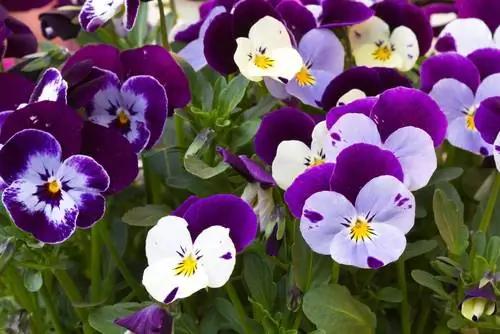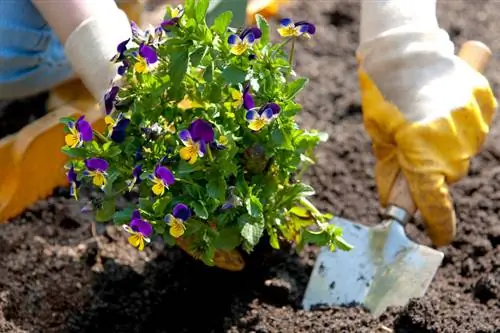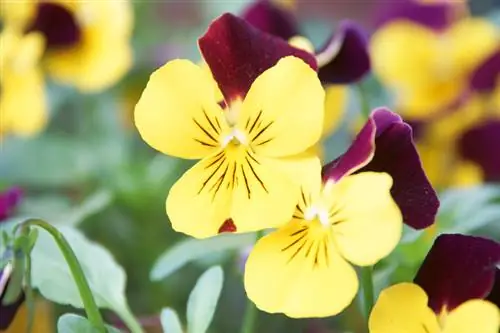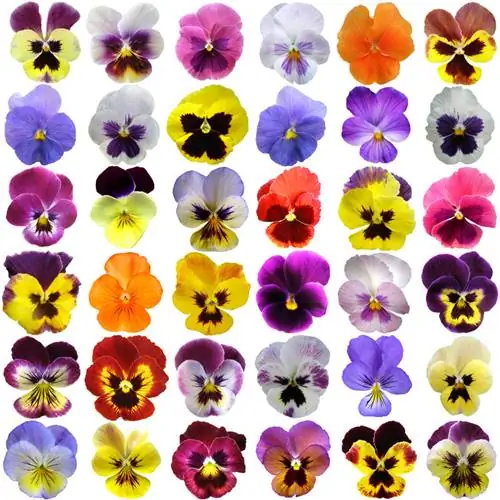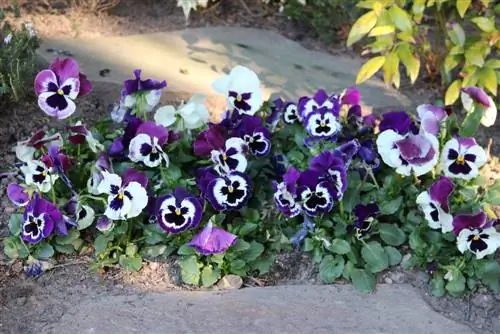- Author admin [email protected].
- Public 2023-12-25 17:45.
- Last modified 2025-01-23 11:22.
Horn violets decorate the garden with floral carpets, frame beds and add cheerful, colorful accents in the flower box. Are you thinking about planting these busy flowers? Then any open questions will be answered here.
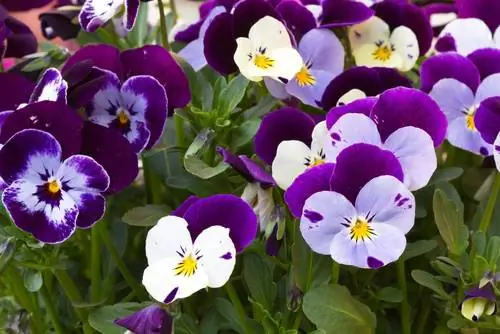
How do I properly care for horned violets?
Horn violets are easy-care, perennial flowering plants that bloom from March until the first frost. They thrive best in sunny to partially shaded locations and nutrient-rich, fresh, moist soil. Regular watering, fertilizing and pruning after flowering promotes their vitality and longevity.
Planting horned violets correctly
Plant early horned violets outdoors from mid-May, because at this early stage of growth ground frost could damage the delicate flowers. Prepare the soil so that it is finely crumbly and enrich it with sifted compost and horn meal. Planted in small tuffs, the cheerful charisma of violets comes into its own wonderfully. If you choose direct sowing as your planting method, follow these steps:
- Prepare a fine, crumbly seedbed in a sunny to partially shaded location in June
- Mix the seeds with bird sand and sow
- Sift the light germinators very thinly with substrate or vermiculite and shower over them
- At a temperature of 15-18 degrees Celsius, the germination time takes 4 weeks
Protect the bed with a close-meshed insect net that also repels pecking birds and voracious snails. From a height of 5 cm with 2 pairs of leaves, separate the horned violets at a distance of 20 cm.read more
Care tips
Take note of the following care program and inspire your horned violets to a never-ending splendor of flowers:
- If there is no rain, we water regularly
- During the flowering period, fertilize with compost (€10.00 on Amazon), guano and horn shavings
- Administer liquid fertilizer in the planter every 2 weeks
- Cut off by half after the first flowering for lush re-blooming
- Winter protection in the bed is only necessary in rough locations, but is advisable in the pot
If you leave the wilted horned violets in the bed after the autumn blooms, they will self-seed. If you prefer to regulate the propagation yourself, cut back close to the ground now. Otherwise, the withered flowers will be cut off before the next shoot in early spring.read more
Which location is suitable?
In a sunny to partially shaded location in nutrient-rich, fresh, moist garden soil, horned violets bloom tirelessly. This means that the busy, continuous bloomers are suitable for almost every corner of the garden, as long as there is no Egyptian darkness there. The location can be airy so that rain and irrigation water can dry off quickly.read more
The correct planting distance
If you maintain a planting distance of 20-25 centimeters, horned violets will not get into each other's enclosure and will still develop a dense carpet of flowers. If you prefer a small variety with a height of 10 centimeters, choose a distance of 10-15 centimeters between the individual flowers.
What soil does the plant need?
Horn violets thrive in any good garden soil that is not too lean and dry in structure. As a substrate in the planter, we recommend a commercially available compost-based potting soil, which is best permeable with the help of a handful of sand.
What is the best time to plant?
Are you thinking about planting lovely horned violets? Then choose a planting time adapted to the chosen planting method:
- Premature Horned Violets: Planting time is from mid-May
- Growing behind glass: Sow from mid-February, plant in May
- Sowing directly in the bed in June and July
Pre-purchased or hand-grown horned violets will delight your gardener with vital blooms in the year they are planted. Specimens sown directly usually take time until the next year before they bloom for the first time.read more
When is flowering time?
Horn violets score points with a long flowering period from March/April to June/July. If you prune in summer, the flowering period will extend into October/November. If winter comes with mild, frost-free weather, the flowers don't think about retreating and continue to bloom diligently.read more
Cut horned violets correctly
As the first flowering period comes to an end in July, horned violets are far from having used up their floral powder. If you now get out the pruning shears and cut off everything that has withered, the new flowers will follow. At the same time, you promote bushy growth and extend the life expectancy of the hard-working ornamental perennials. At the end of the second flowering period, cut back Viola cornuta if seeding is not desired. Otherwise, give free rein to self-sowing and only cut off the withered leaves close to the ground before the next shoots in spring.
Watering horned violets
Horn violets don't like drought. Therefore, water regularly if the natural rainfall is not sufficient. Check the substrate in the bucket and balcony box every 2 days and water if the surface has dried out. Please note that there is also a need for watering in winter when there is clear frost. Since there is no snow as a source of water in this weather, water on mild days.
Fertilize horned violets properly
In the bed, the eager ornamental flowers enjoy a portion of compost every 2-3 weeks as long as the flowering period lasts. In pots and flower boxes, supplying nutrients is easier by hand with liquid fertilizer or fertilizer sticks. Avoid nitrogen-based complete fertilizer, as this promotes leaf growth at the expense of abundant flowering.read more
Diseases
Horn violets are one of the favorite prey schemes for cunning fungal spores of mildew. At summer temperatures of 20 degrees Celsius or more, a mealy-white patina spreads on the lower and upper sides of the leaves, which causes the foliage to die off as it progresses. This is how you can combat the disease using environmentally friendly means:
- Cut off all infected horned violets and dispose of them in household waste
- Spray the remaining flowers repeatedly with a mix of fresh milk and water in a ratio of 1:9
In order to avoid providing a target for the widespread fungal infection, horned violets should not be sprayed with water if possible. Careful weeding also contributes to prevention, as numerous weeds spread the pathogens.
Wintering
Mother Nature endowed horned violets with robust winter hardiness. In the bed, protection in the form of leaves, straw or needles is only necessary in rough locations. Since the root balls in the pot are more vulnerable to frost, cover planters with felt, jute or bubble wrap. If the weather is frosty, dry, water Viola cornuta on mild days.read more
Propagate Horned Violets
You don't get tired of your horned violets? Then propagate the eager ornamental perennials using one of the following methods:
- Sowing behind glass from mid-February
- Sowing directly in the bed from the beginning of June
- Dividing the root balls in spring or autumn
- Cut cuttings in summer
- Remove root runners in spring or autumn
Not every horned violet variety is suitable for every propagation method. Small flowers with a height of 5 centimeters are not suitable for propagation from cuttings. Other hybrids do not develop root runners.read more
horn violet in pot
The distinctive blooms of horned violets come into their own in a pot. So that you can enjoy the abundance of colors for a long time, a drainage system made of pebbles or grit above the water drain in the floor prevents destructive waterlogging. Choose a good quality compost-based potting soil as the substrate and add some sand or perlite. This is how care works:
- If the potting soil dries, it is watered
- During the flowering period, fertilize liquidly every 2 weeks
- Cut back by half after the first flowering
- Prune close to the ground at the latest before fresh shoots
For horned violets in pots, we recommend overwintering them frost-free in a bright location. The smaller the planter, the greater the risk that the root ball will freeze. Water occasionally during the cold season to prevent the flowers from drying out.
Is horned violet poisonous?
Horned violets pose no he alth risk to humans or animals. On the contrary, the delicate flowers are even edible. Creative chefs use fresh horned violets to colorfully decorate desserts, salads, cold buffets and refreshing drinks.read more
How do horned violets differ from pansies?
Anyone who botanically lumps horned violets and pansies together overlooks the following characteristics that characterize each of these flowers:
- The flower of pansies is twice as big at 6 cm
- Horn violets thrive in many numbers, decorated with a spur in the middle of the flower
The most noticeable difference can be found in the flowering period. While pansies bloom from April to July, horned violets bloom tirelessly from March until the first frost and also make a colorful appearance in mild winters.read more
How do horned violets thrive as perennials?
In every horned violet there is the vitality for cultivation over several years. The primary requirement is a little attention from the gardener. With this care, the distinctive flowers will stay with you for several years:
- Fertilize and water regularly
- Clean out faded flowers and cut back after flowering
- Rejuvenation by division in spring, cuttings in September, cuttings in summer or sowing
In winter, only cover sensitive varieties with leaves or brushwood to avoid causing fungi or rot. Water when there is a clear frost on mild days. If horned violets become limp in the second year, they are usually not frozen, but dried up.read more
Are violet flowers edible?
If a hobby gardener also has the heart of a gourmet, you will appreciate the flowers of horned violets in creative cooking. Violet flowers not only delight the eye in the bed and on the balcony, but also serve as a tasty decoration on salads, desserts, cold plates and tempting cakes. It is best to choose horned violets that you have cared for yourself, as in this case you can be sure that no pesticides have poisoned the flowers.read more
Beautiful varieties
- Etain: a violet dream with light yellow flowers edged in subtle violet, robust and richly blooming
- Hansa: a historic variety with bright blue-purple flowers from April
- Rebecca: the flower impresses with wavy petals, marbled in creamy white and purple
- Irish Molly: a somewhat delicate variety with a unique coloring in copper, chestnut brown and yellow
- Milkmaid: the 10 cm small, milky white horned violet develops dense flower pads even without pruning

